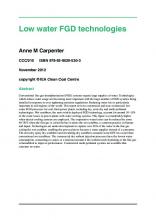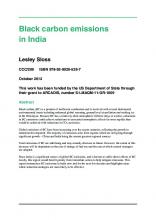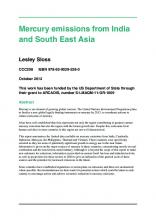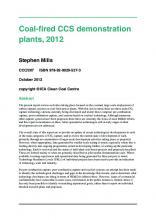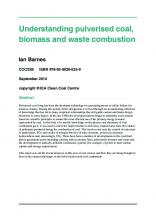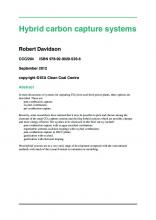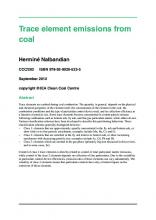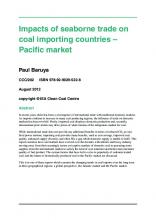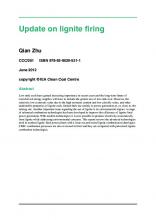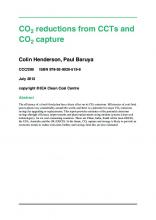January 1st, 2013
CCC/210 ISBN 978-92-9029-530-3
November 2012
copyright © IEA Clean Coal Centre
Abstract
Conventional flue gas desulphurisation (FGD) systems require large supplies of water. Technologies
which reduce water usage are becoming more important with the large number of FGD systems being
installed in response to ever tightening emission regulations. Reducing water loss is particularly
important in arid regions of the world. This report reviews commercial and near commercial low
January 1st, 2013
CCC/209 ISBN 978-92-9029-529-7
October 2012
This work has been funded by the US Department of State through
their grant to ARCADIS, number S-LMAQM-11-GR-1009
Abstract
Black carbon (BC) is a product of inefficient combustion and is involved with several detrimental
environmental issues including enhanced global warming, ground level air pollution and melting ice
in the Himalayas. Because BC has a relatively short atmospheric lifetime (days or weeks), reductions
January 1st, 2013
CCC208 ISBN 978-92-9029-528-0
October 2012
This work has been funded by the US Department of State through
their grant to ARCADIS, number S-LMAQM-11-GR-1009
Abstract
Mercury is an element of growing global concern. The United Nations Environment Programme plans
to finalise a new global legally binding instrument on mercury by 2013, to coordinate actions to
reduce emissions of mercury.
It has been well established that Asia represents not only the region contributing to greatest current
January 1st, 2013
Abstract
The present report reviews activities taking place focused on the eventual large-scale deployment of
carbon capture systems on coal-fired power plants. With this aim in mind, there are three main CO2
capture technology streams currently being developed and tested; these comprise pre-combustion
capture, post-combustion capture, and systems based on oxyfuel technology. Although numerous
other capture systems have been proposed, these three are currently the focus of most RD&D efforts
September 1st, 2013
CCC/205 ISBN 978-92-9029-525-9
September 2012
copyright © IEA Clean Coal Centre
Abstract
Pulverised coal firing has been the dominant technology for generating power in utility boilers for
almost a century. During this period, boiler designs have evolved through an accumulating collection
of knowledge that has led to many empirical relationships that still guide current and future design
directions to some degree. In the late 1940s the developed nations began to undertake coal research
January 1st, 2013
CCC/204 ISBN 978-92-9029-526-6
September 2012
copyright © IEA Clean Coal Centre
Abstract
In most discussions of systems for capturing CO2 from coal-fired power plants, three options are
described. These are:
* post-combustion capture;
* oxyfuel combustion;
* pre-combustion capture.
Recently, some researchers have realised that it may be possible to pick and choose among the
January 1st, 2013
CCC/203 ISBN 978-92-9029-523-5
September 2012
copyright © IEA Clean Coal Centre
Abstract
Trace elements are emitted during coal combustion. The quantity, in general, depends on the physical
and chemical properties of the element itself, the concentration of the element in the coal, the
combustion conditions and the type of particulate control device used, and its collection efficiency as
a function of particle size. Some trace elements become concentrated in certain particle streams
January 1st, 2013
CCC/202 ISBN 978-92-9029-522-8
August 2012
copyright © IEA Clean Coal Centre
Abstract
In recent years, there has been a convergence of international trade with traditional domestic markets.
As imports continue to increase in many coal producing regions, the influence of trade on domestic
markets has been twofold. Firstly, imported coal displaces domestic production and, secondly,
international price trends may drive prices of what remains of the indigenous market for coal.
January 1st, 2013
CCC/201 ISBN 978-92-9029-521-1
June 2012
copyright © IEA Clean Coal Centre
Abstract
Low rank coals have gained increasing importance in recent years and the long-term future of
coal-derived energy supplies will have to include the greater use of low rank coal. However, the
relatively low economic value due to the high moisture content and low calorific value, and other
undesirable properties of lignite coals limited their use mainly to power generation at, or, close to, the
January 1st, 2013
CCC/200 ISBN 978-92-9029-519-8
July 2012
copyright © IEA Clean Coal Centre
Abstract
The efficiency of a fossil-fired plant has a direct effect on its CO2 emissions. Efficiencies of coal-fired
power plants vary considerably around the world, and there is a potential for major CO2 emissions
savings by upgrading or replacements. This report provides estimates of the potential emissions
savings through efficiency improvements and plant replacements using modern systems (clean coal
Pages

